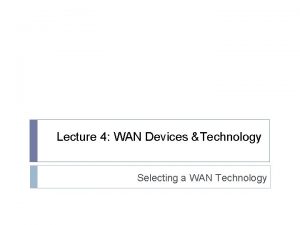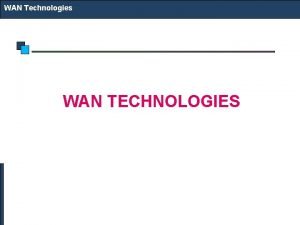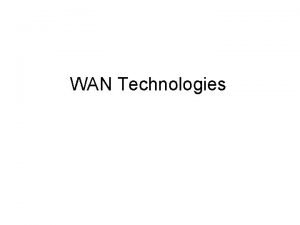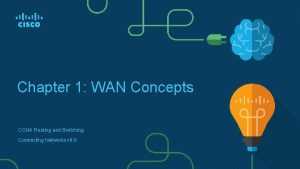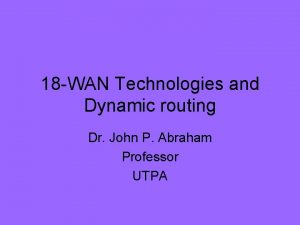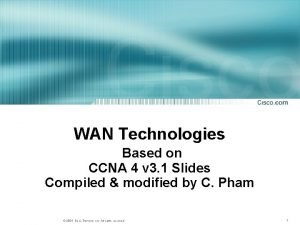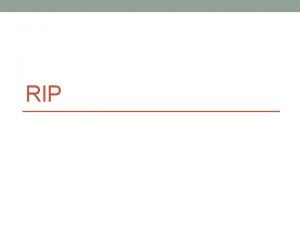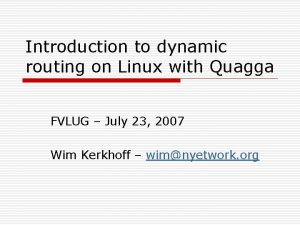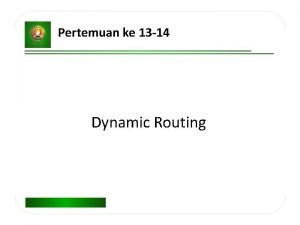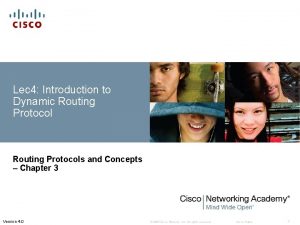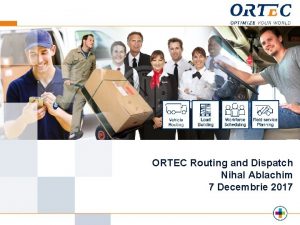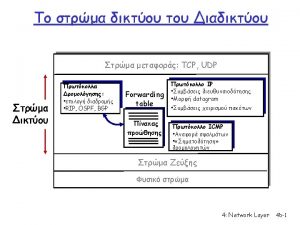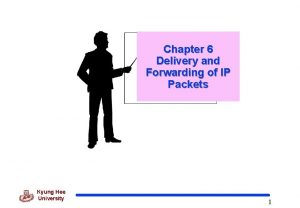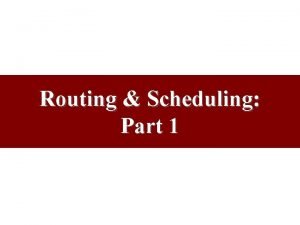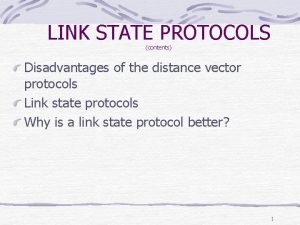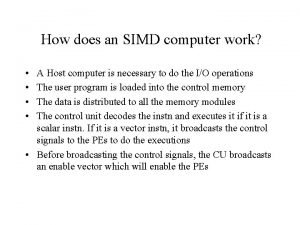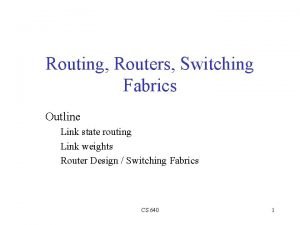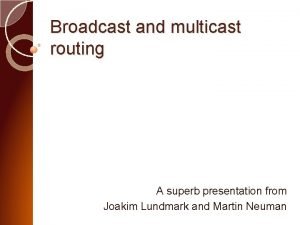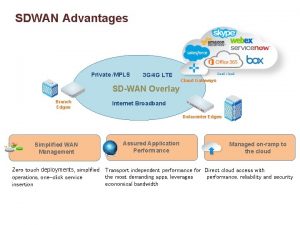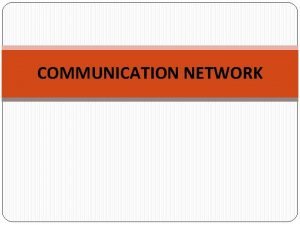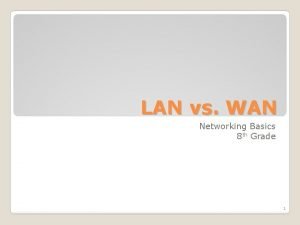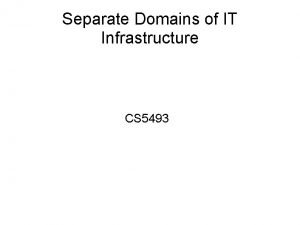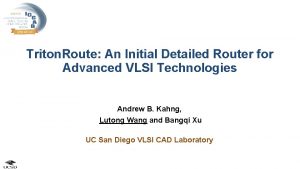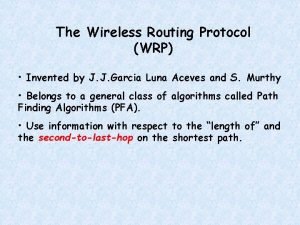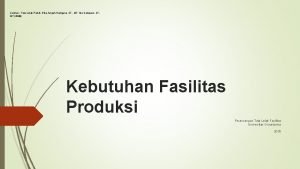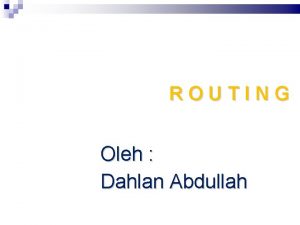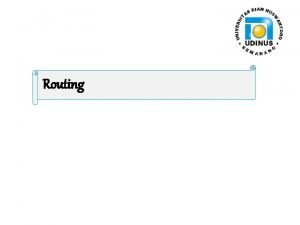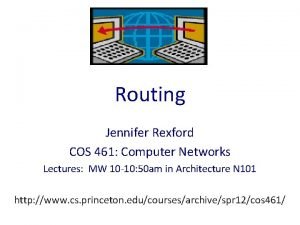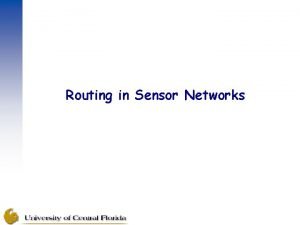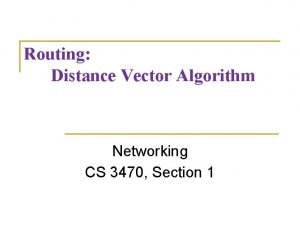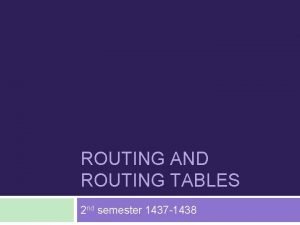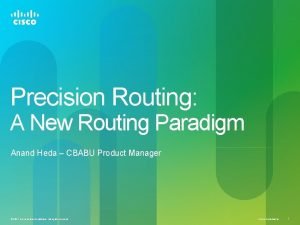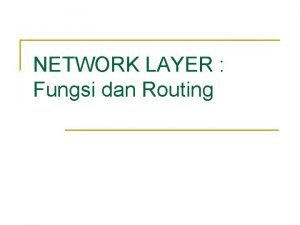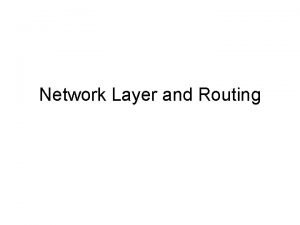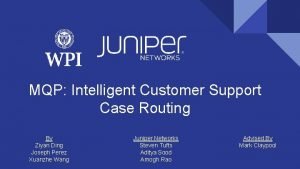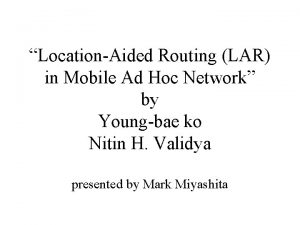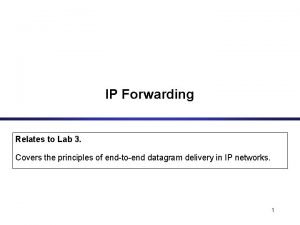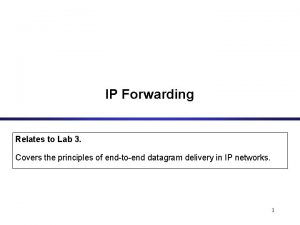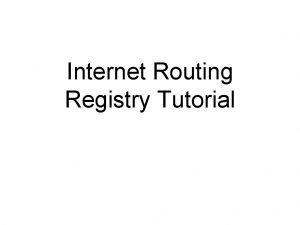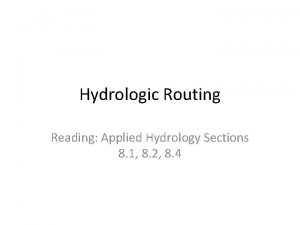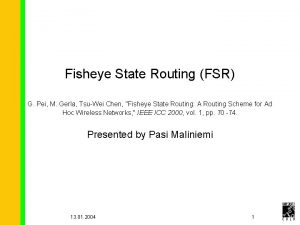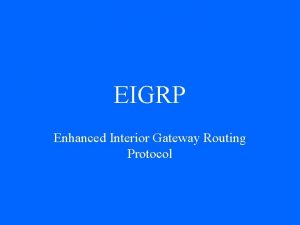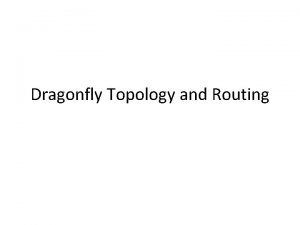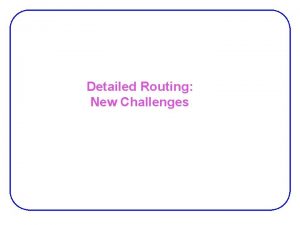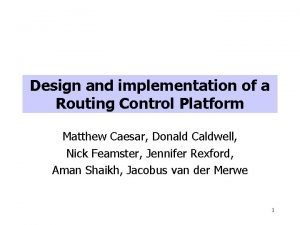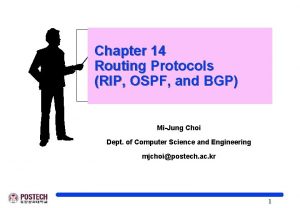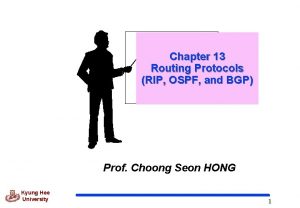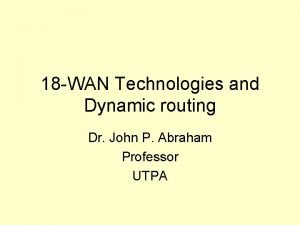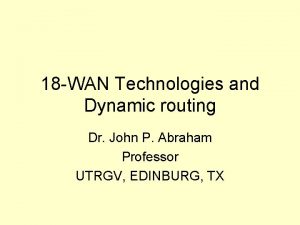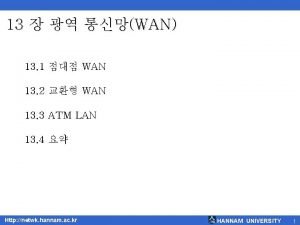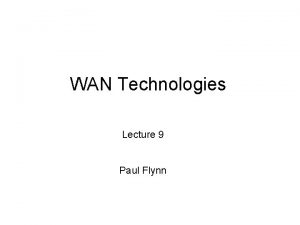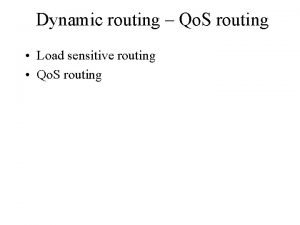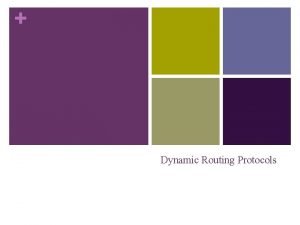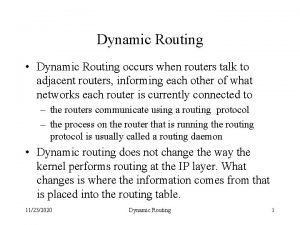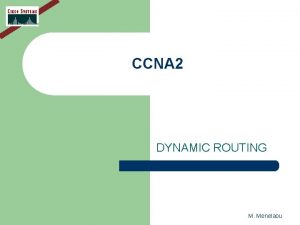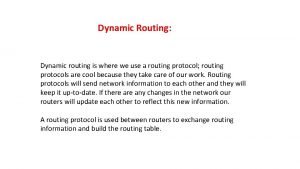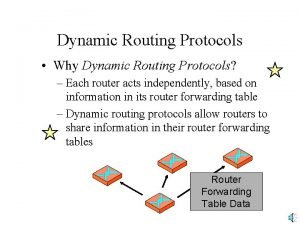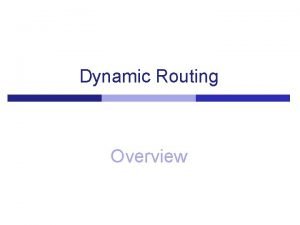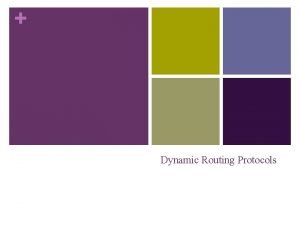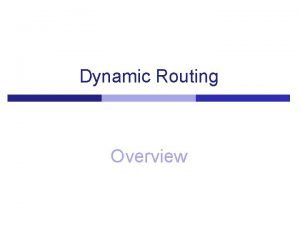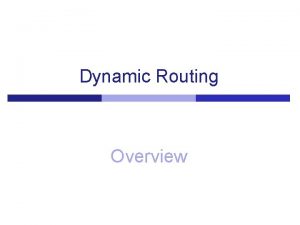18 WAN Technologies and Dynamic routing Dr John











































































- Slides: 75

18 -WAN Technologies and Dynamic routing Dr. John P. Abraham Professor UTRGV, EDINBURG, TX


Traditional WAN architecture • Packet switches (specialized computers) were used to direct packets. WAN existed before LAN. When LAN was introduced the packet switching was divided into local and outside. Layer two was assigned LAN and layer 3 WAN. • Many WANs used leased circuits. • WANs were formed by interconnecting packet switches

Store and forward Paradigm • Packet switch buffers packets in memory to compensate for the speed of the routes. • The store operation occurs as the packet arrive • The forward operation occurs once a packet has arrived and waiting in memory. The processor examines the packet, determines its destination and sends the packet over the appropriate interface. • Structure of a router: 4 components – Input ports, output ports, routing processor and switching fabric. The routing processor has other components, such as the buffer, boot ROM, nvram, etc.

Addressing • Hierarchical addressing has two parts, site and the computer at that site. The first part of the address actually identifies a router (not exactly, we will discuss this later). IP addresses are not permanent. • Once the packet arrives at the router, then it queries all computers to find out which machine has a particular IP address. The machine with that address responds with its MAC address and the packet converted to frame is sent to that address. MAC addresses are permanent to a machine.

Next-Hop routing – When a packet arrives, the routing processor must choose an outgoing path. If it is destined for a local computer, the router sends to that computer using its MAC address. Otherwise, it is forwarded to one of the output ports on the router that leads to the destination. – To do this the router examines the destination address and extracts the network portion of the address. If the extracted address matches its own the packets are kept otherwise forwarded. – The router does not need to know the complete routing information, rather just next-hop. Think of baggage transport in the airlines. – Forwarding has nothing to do with the source (source independence)

Dynamic routing updates in wan • Each router must have a forwarding table. The table must guarantee: – Universal communication – a valid next-hop route for each possible destination. – Optimal routes. The route must be shortest path, either in hops, time, or using other factors. • If two paths exist, one become unavailable (hardware failure, routes should be tested), forwarding table should be changed. So the table must be dynamic.

A network

Explanation of the figure • Nodes in the graph are given a label (address of the router). Graph can be used to discover next hop, and shortest path. – To reach node 4 from node 1, the next hops are given 1, 3, and 3, 4. Alternatively, we can discover next hop as 1, 3, 3, 2 and 2, 4. We can actually prepare a table of next hop for each router to reach all the others.

Shortest Path computation in a graph See my notes: shortest path Dijkstra’s agorithm Next hop table is constructed during the computation of shortest path In this algorithm, the edges in a graph can assume any non-negative value. i. e. Weight.

Default routes In case of router one, next hop is 1, 3 regardless where you are going. So instead of listing 1, 3 three times, why don’t we have one default entry as 1, 3. So, we can have next hops for the ones we know, and all the repeated ones should have a default route. Default route is optional.

Forwarding table Static routing. All routes are entered into the router and it does not change. The routes are stored therefore, upon reboot it will retain these routes. In case of a down line, the router can’t send any more packets to that destination. Dynamic routing. Initial routing table is keyed in. Then in learns all the other routes. Most routers today use dynamic table.

Routing problems Link State Routing (shortest path first) – routers periodically send messages across the network that carry status of the link (up, down), these messages can be used to build graphs. If packets are lost then two routers can disagree about the shortest path. Distance Vector routing Each link is assigned a weight. The distance the destination is the total of all weights. It also sends periodic messages, but adds weight like “I can reach destination x, and its current distance from me is Y”. DVR can create a loop, by one saying it can’t reach, and the neighbor saying it can reach through the one just reported it can’t reach. DVR employs split horizon to prevent this loop (router does not send information back to the one reported it can’t reach).

A MORE DETAILED LOOK AT ROUTING

Connection vs connectionless • In connection oriented, the network layer first makes a connection and all packets are sent over that connection. No need to calculate route for each packet • In connectionless each packet is treated independently, route is determined independently. Packets may arrive at different times. TCP/IP Protocol Suite 15

Figure 6. 1 Direct delivery TCP/IP Protocol Suite 16

Direct Delivery • The final sender and Receiver connected to the same network. • Destination IP address is mapped to destination MAC address. • In indirect delivery, the sender uses the destination IP address and the routing table to find the IP address of the next router. This called routing or forwarding. TCP/IP Protocol Suite 17

Figure 6. 2 Indirect delivery TCP/IP Protocol Suite 18

6. 2 FORWARDING Forwarding means to place the packet in its route to its destination. Forwarding requires a host or a router to have a routing table. . The topics discussed in this section include: Forwarding Techniques Forwarding with Classful Addressing Forwarding with Classless Addressing Combination TCP/IP Protocol Suite 19

Route based vs. next hop • Top part of next slide shows table based on route. • Bottom part shows table based on next hop. TCP/IP Protocol Suite 20

Figure 6. 3 Next-hop method TCP/IP Protocol Suite 21

Network –specific routing • All hosts connected to the same network will only have one entry. • Therefore will have a smaller table • See next slide TCP/IP Protocol Suite 22

Figure 6. 4 Network-specific method TCP/IP Protocol Suite 23

Host Specific Routing • Every host is listed • Good for security measures – Administrator may not want packets go through any other route. • See next slide TCP/IP Protocol Suite 24

Figure 6. 5 Host-specific routing TCP/IP Protocol Suite 25

Figure 6. 6 Default routing For all hosts or networks not listed TCP/IP Protocol Suite 26

Forwarding with classfull addressing • Most routers in the global internet are not involved with routing. • Forwarding is based on class and network address (using network specific routing) • Packet extract distination address findclass extract network address Search table ARP for the next router TCP/IP Protocol Suite 27

Figure 6. 7 Simplified forwarding module in classful address without subnetting TCP/IP Protocol Suite 28

Example 1 Figure 6. 8 shows an imaginary part of the Internet. Show the routing tables for router R 1. See Next Slide TCP/IP Protocol Suite 29

Figure 6. 8 Configuration for routing, Example 1 TCP/IP Protocol Suite 30

Example 1 (Continued) Solution Figure 6. 9 shows the three tables used by router R 1. Note that some entries in the next-hop address column are empty because in these cases, the destination is in the same network to which the router is connected (direct delivery). In these cases, the next-hop address used by ARP is simply the destination address of the packet as we will see in Chapter 7. See Next Slide TCP/IP Protocol Suite 31

Figure 6. 9 Tables for Example 1 TCP/IP Protocol Suite 32

Example 2 Router R 1 in Figure 6. 8 receives a packet with destination address 192. 16. 7. 14. Show the packet is forwarded. Solution The destination address in binary is 11000000 000100000111 00001110. A copy of the address is shifted 28 bits to the right. The result is 00000000 00001100 or 12. The destination network is class C. The network address is extracted by masking off the leftmost 24 bits of the destination address; the result is 192. 16. 7. 0. The table for Class C is searched. The network address is found in the first row. The next -hop address 111. 15. 17. 32. and the interface m 0 are passed to ARP. TCP/IP Protocol Suite 33

Example 3 Router R 1 in Figure 6. 8 receives a packet with destination address 167. 24. 160. 5. Show the packet is forwarded. Solution The destination address in binary is 10100111 00011000 10100000101. A copy of the address is shifted 28 bits to the right. The result is 00000000 00001010 or 10. The class is B. The network address can be found by masking off 16 bits of the destination address, the result is 167. 24. 0. 0. The table for Class B is searched. No matching network address is found. The packet needs to be forwarded to the default router (the network is somewhere else in the Internet). The next-hop address 111. 30. 31. 18 and the interface number m 0 are passed to ARP. TCP/IP Protocol Suite 34

Figure 6. 10 TCP/IP Protocol Suite Simplified forwarding module in classful address with subnetting 35

Example 4 Figure 6. 11 shows a router connected to four subnets. See Next Slide TCP/IP Protocol Suite 36

Example 4 (Continued) Note several points. First, the site address is 145. 14. 0. 0/16 (a class B address). Every packet with destination address in the range 145. 14. 0. 0 to 145. 14. 255 is delivered to the interface m 4 and distributed to the final destination subnet by the router. Second, we have used the address x. y. z. t/n for the interface m 4 because we do not know to which network this router is connected. Third, the table has a default entry for packets that are to be sent out of the site. The router is configured to apply the mask /18 to any destination address. TCP/IP Protocol Suite 37

Figure 6. 11 TCP/IP Protocol Suite Configuration for Example 4 38

Example 5 The router in Figure 6. 11 receives a packet with destination address 145. 14. 32. 78. Show the packet is forwarded. Solution The mask is /18. After applying the mask, the subnet address is 145. 14. 0. 0. The packet is delivered to ARP with the next-hop address 145. 14. 32. 78 and the outgoing interface m 0. TCP/IP Protocol Suite 39

Example 6 A host in network 145. 14. 0. 0 in Figure 6. 11 has a packet to send to the host with address 7. 22. 67. 91. Show the packet is routed. Solution The router receives the packet and applies the mask (/18). The network address is 7. 22. 64. 0. The table is searched and the address is not found. The router uses the address of the default router (not shown in figure) and sends the packet to that router. TCP/IP Protocol Suite 40

Note: In classful addressing we can have a routing table with three columns; in classless addressing, we need at least four columns. TCP/IP Protocol Suite 41

Figure 6. 12 TCP/IP Protocol Suite Simplified forwarding module in classless address 42

Example 7 Make a routing table for router R 1 using the configuration in Figure 6. 13. See Next Slide Solution Table 6. 1 shows the corresponding table. See the table after the figure. TCP/IP Protocol Suite 43

Figure 6. 13 TCP/IP Protocol Suite Configuration for Example 7 44

Table 6. 1 Routing table for router R 1 in Figure 6. 13 TCP/IP Protocol Suite 45

Example 8 Show the forwarding process if a packet arrives at R 1 in Figure 6. 13 with the destination address 180. 70. 65. 140. Solution The router performs the following steps: 1. The first mask (/26) is applied to the destination address. The result is 180. 70. 65. 128, which does not match the corresponding network address. See Next Slide TCP/IP Protocol Suite 46

Example 8 (Continued) 2. The second mask (/25) is applied to the destination address. The result is 180. 70. 65. 128, which matches the corresponding network address. The next-hop address (the destination address of the packet in this case) and the interface number m 0 are passed to ARP for further processing. TCP/IP Protocol Suite 47

Example 9 Show the forwarding process if a packet arrives at R 1 in Figure 6. 13 with the destination address 201. 4. 22. 35. Solution The router performs the following steps: See Next Slide TCP/IP Protocol Suite 48

Example 9 (Continued) 1. The first mask (/26) is applied to the destination address. The result is 201. 4. 22. 0, which does not match the corresponding network address (row 1). 2. The second mask (/25) is applied to the destination address. The result is 201. 4. 22. 0, which does not match the corresponding network address (row 2). 3. The third mask (/24) is applied to the destination address. The result is 201. 4. 22. 0, which matches the corresponding network address. The destination address of the package and the interface number m 3 are passed to ARP. TCP/IP Protocol Suite 49

Example 10 Show the forwarding process if a packet arrives at R 1 in Figure 6. 13 with the destination address 18. 24. 32. 78. Solution This time all masks are applied to the destination address, but no matching network address is found. When it reaches the end of the table, the module gives the next-hop address 180. 70. 65. 200 and interface number m 2 to ARP. This is probably an outgoing package that needs to be sent, via the default router, to some place else in the Internet. TCP/IP Protocol Suite 50

Example 11 Now let us give a different type of example. Can we find the configuration of a router, if we know only its routing table? The routing table for router R 1 is given in Table 6. 2. Can we draw its topology? See Next Slide TCP/IP Protocol Suite 51

Table 6. 2 Routing table for Example 11 TCP/IP Protocol Suite 52

Example 11 (Continued) Solution We know some facts but we don’t have all for a definite topology. We know that router R 1 has three interfaces: m 0, m 1, and m 2. We know that there are three networks directly connected to router R 1. We know that there are two networks indirectly connected to R 1. There must be at least three other routers involved (see next-hop column). We know to which networks these routers are connected by looking at their IP addresses. So we can put them at their appropriate place. TCP/IP Protocol Suite See Next 53 Slide

Example 11 (Continued) We know that one router, the default router, is connected to the rest of the Internet. But there is some missing information. We do not know if network 130. 4. 8. 0 is directly connected to router R 2 or through a point-to-point network (WAN) and another router. We do not know if network 140. 6. 12. 64 is connected to router R 3 directly or through a point-to-point network (WAN) and another router. Point-to-point networks normally do not have an entry in the routing table because no hosts are connected to them. Figure 6. 14 shows our guessed topology. See Next Slide TCP/IP Protocol Suite 54

Figure 6. 14 TCP/IP Protocol Suite Guessed topology for Example 6 55

Figure 6. 15 TCP/IP Protocol Suite Address aggregation 56

Figure 6. 16 TCP/IP Protocol Suite Longest mask matching 57

Example 12 As an example of hierarchical routing, let us consider Figure 6. 17. A regional ISP is granted 16384 addresses starting from 120. 14. 64. 0. The regional ISP has decided to divide this block into four subblocks, each with 4096 addresses. Three of these subblocks are assigned to three local ISPs, the second subblock is reserved for future use. Note that the mask for each block is /20 because the original block with mask /18 is divided into 4 blocks. See Next Slide TCP/IP Protocol Suite 58

Figure 6. 17 TCP/IP Protocol Suite Hierarchical routing with ISPs 59

Example 12 (Continued) The first local ISP has divided its assigned subblock into 8 smaller blocks and assigned each to a small ISP. Each small ISP provides services to 128 households (H 001 to H 128), each using four addresses. Note that the mask for each small ISP is now /23 because the block is further divided into 8 blocks. Each household has a mask of /30, because a household has only 4 addresses (232− 30 is 4). The second local ISP has divided its block into 4 blocks and has assigned the addresses to 4 large organizations (LOrg 01 to LOrg 04). Note that each large organization has 1024 addresses and the mask is /22. TCP/IP Protocol Suite See Next 60 Slide

Example 12 (Continued) The third local ISP has divided its block into 16 blocks and assigned each block to a small organization (SOrg 01 to SOrg 15). Each small organization has 256 addresses and the mask is /24. There is a sense of hierarchy in this configuration. All routers in the Internet send a packet with destination address 120. 14. 64. 0 to 120. 14. 127. 255 to the regional ISP. The regional ISP sends every packet with destination address 120. 14. 64. 0 to 120. 14. 79. 255 to Local ISP 1 sends every packet with destination address 120. 14. 64. 0 to 120. 14. 64. 3 to H 001. TCP/IP Protocol Suite 61

6. 3 ROUTING Routing deals with the issues of creating and maintaining routing tables. The topics discussed in this section include: Static Versus Dynamic Routing Tables Routing Table TCP/IP Protocol Suite 62

Figure 6. 18 TCP/IP Protocol Suite Common fields in a routing table 63

Example 13 One utility that can be used to find the contents of a routing table for a host or router is netstat in UNIX or LINUX. The following shows the listing of the contents of the default server. We have used two options, r and n. The option r indicates that we are interested in the routing table and the option n indicates that we are looking for numeric addresses. Note that this is a routing table for a host, not a router. Although we discussed the routing table for a router throughout the chapter, a host also needs a routing table. TCP/IP Protocol Suite See Next Slide 64

Example 13 (continued) $ netstat -rn Kernel IP routing table Destination Gateway 153. 18. 16. 0 0. 0 127. 0. 0. 0 153. 18. 31. Mask Flags Iface 255. 240. 0 U eth 0 255. 0. 0. 0 U lo 254 0. 0 See Next Slide TCP/IP Protocol Suite 65 UG eth 0.

Example 13 (continued) More information about the IP address and physical address of the server can be found using the ifconfig command on the given interface (eth 0). $ ifconfig eth 0 Link encap: Ethernet inet addr: 153. 18. 17. 11 HWaddr 00: B 0: DF: 09: 5 D Bcast: 153. 18. 31. 255 Mask: 255. 240. 0 . . From the above information, we can deduce the configuration of the server as shown in Figure 6. 19. See Next Slide TCP/IP Protocol Suite 66

Figure 6. 19 TCP/IP Protocol Suite Configuration of the server for Example 13 67

6. 4 STRUCTURE OF A ROUTER We represent a router as a black box that accepts incoming packets from one of the input ports (interfaces), uses a routing table to find the departing output port, and sends the packet from this output port. The topics discussed in this section include: Components TCP/IP Protocol Suite 68

Figure 6. 20 TCP/IP Protocol Suite Router components 69

Figure 6. 21 TCP/IP Protocol Suite Input port 70

Figure 6. 22 TCP/IP Protocol Suite Output port 71

Figure 6. 23 TCP/IP Protocol Suite Crossbar switch 72

Figure 6. 24 TCP/IP Protocol Suite A banyan switch 73

Figure 6. 25 TCP/IP Protocol Suite Examples of routing in a banyan switch 74

Figure 6. 26 TCP/IP Protocol Suite Batcher-banyan switch 75
 Mark tinka
Mark tinka Flood routing meaning
Flood routing meaning Hydrologic routing and hydraulic routing
Hydrologic routing and hydraulic routing Give comparison of clock routing and power routing
Give comparison of clock routing and power routing Private wan
Private wan Dedicated line
Dedicated line Leased line wan technology
Leased line wan technology Wan technologies atm
Wan technologies atm Public wan technologies
Public wan technologies Dr john wan
Dr john wan Wan concepts
Wan concepts Wan technologies ccna
Wan technologies ccna Difference between dynamic and static routing
Difference between dynamic and static routing Igrp configuration in packet tracer
Igrp configuration in packet tracer Linux dynamic routing
Linux dynamic routing Dynamic routing
Dynamic routing Introduction to dynamic routing protocols
Introduction to dynamic routing protocols Transferered
Transferered John proctor iii
John proctor iii Ortec routing and dispatch
Ortec routing and dispatch Interplay between routing and forwarding
Interplay between routing and forwarding Delivery and routing of ip packets
Delivery and routing of ip packets Principles of good routing and scheduling
Principles of good routing and scheduling Advantages and disadvantages of distance vector routing
Advantages and disadvantages of distance vector routing Masking and data routing mechanism
Masking and data routing mechanism Routing and switching protocols
Routing and switching protocols Abderazek ben abdallah
Abderazek ben abdallah Lab 4-1: routing concepts and protocols
Lab 4-1: routing concepts and protocols Broadcast and multicast routing
Broadcast and multicast routing Igmpv
Igmpv Inter vlan routing layer 3 switch
Inter vlan routing layer 3 switch Advantages and disadvantages of mpls
Advantages and disadvantages of mpls Characteristics of lan and wan
Characteristics of lan and wan Difference lan wan
Difference lan wan Wan and lan
Wan and lan Why so pale and wan
Why so pale and wan Lan wan basics
Lan wan basics Robert herrick visual house
Robert herrick visual house 7 it infrastructure domains
7 it infrastructure domains Ap layer in vlsi
Ap layer in vlsi Link2be
Link2be Contoh mppc
Contoh mppc Cisco srv6
Cisco srv6 Rumor routing
Rumor routing Routing statyczny
Routing statyczny Routing overlays
Routing overlays Tabel routing static
Tabel routing static Tabel routing
Tabel routing Path vector routing
Path vector routing Rumour routing
Rumour routing Distance vector routing example
Distance vector routing example Routing area update
Routing area update Routing table
Routing table Cisco cuic
Cisco cuic Fungsi dari network layer
Fungsi dari network layer Network layer responsibility
Network layer responsibility Intelligent customer routing
Intelligent customer routing Lar routing protocol
Lar routing protocol Routing table longest prefix match
Routing table longest prefix match Eth2r
Eth2r Irrpt
Irrpt 3pd06
3pd06 Hydrologic routing
Hydrologic routing Pei wei polaris
Pei wei polaris Enhanced interior gateway routing protocol
Enhanced interior gateway routing protocol Dragonfly network topology
Dragonfly network topology Detailed routing
Detailed routing Routing control platform
Routing control platform Algorithms in computer networks
Algorithms in computer networks Lab - configure router-on-a-stick inter-vlan routing
Lab - configure router-on-a-stick inter-vlan routing Management of sales territories and quotas
Management of sales territories and quotas Rip ospf bgp
Rip ospf bgp Rip ospf bgp
Rip ospf bgp Routing patterns in sales
Routing patterns in sales Objectives of routing
Objectives of routing Wsecu routing number
Wsecu routing number




